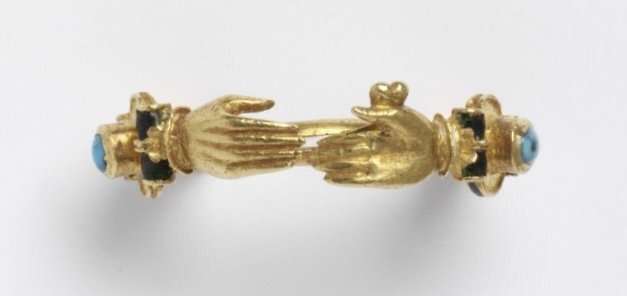Gimmel Rings
Symbols of love, unity, life and death
What is a Gimmel Ring?
A gimmel ring is a type of ring that consists of two or more interlocking bands that can be separated. The name "gimmel" derives from the Middle English word "gimel," meaning "twin." Traditionally, these rings were often used as betrothal or wedding rings, signifying the bond between partners.
Gimmel rings date back to the 16th century, particularly in Europe. They gained popularity during the Renaissance, a time marked by a renewed interest in art, science, and human emotion. Initially crafted in gold or silver, gimmel rings were designed to be split into two parts, each worn by one partner. This represented the union of two individuals while allowing them to maintain a sense of individuality.
These rings were often inscribed with romantic verses or symbols, enhancing their sentimental value. In some cases, the rings were also designed to hold gemstones, further showcasing the craftsmanship of the era.
The Renaissance Gimmel Ring with Momento MoriOnce owned by the Rothschild family, this spectacular ring celebrates love and death coexisting together for this ring is not only a memento mori but also a wedding ring. The bezel combines a table-cut diamond on one side with a vivid, red ruby on the other. When opened, the bezel reveals two hidden chambers, and a tiny gold- and white-enameled baby curls inside one cavity, while a similarly constructed skeleton nestles inside its companion. The inscription declares: "Whom God has joined together, let no man tear asunder."Evolution Through the Ages
As styles evolved, so did the design of gimmel rings. By the 17th and 18th centuries, these rings became increasingly ornate, incorporating intricate designs and elaborate engravings. The Industrial Revolution brought about mass production, making jewelry more accessible. However, the craftsmanship of gimmel rings often remained artisanal, appealing to those who cherished bespoke items.
18th Century gimmel rings with intricate design, stone setting and inscriptions.
Photo via Victoria & Albert Museum.
In the Victorian era, gimmel rings saw a resurgence, particularly in the form of puzzle rings, which added a playful element to their design. These rings required the wearer to fit the pieces together, symbolizing the complexity and interdependence of relationships.
Gimmel Rings Today
In contemporary jewelry, gimmel rings have experienced a revival, appreciated for their unique design and deep symbolism. Modern artisans have reinterpreted traditional styles, using a variety of materials, including alternative metals and ethically sourced gemstones.
Today, gimmel rings are often chosen for engagements and weddings, symbolizing commitment and partnership. Couples may also customize their gimmel rings with personal engravings or unique designs, making each piece a reflection of their love story.
Many couples view gimmel rings as heirloom pieces, passing them down through generations. This tradition enriches the ring's narrative, connecting families and celebrating enduring love. With their historical significance and modern appeal, gimmel rings continue to capture the hearts of many.
Conclusion
Gimmel rings stand as timeless symbols of love and unity, bridging the gap between history and modernity. Their intricate designs and meaningful symbolism make them more than just jewelry; they are cherished tokens of connection and commitment. Whether worn as engagement rings or treasured heirlooms, gimmel rings remain a beautiful testament to the enduring power of love. As we move forward, these rings will undoubtedly continue to evolve, capturing new stories and emotions for generations to come.
-
Ashton Berglund
*all photos and information stated are for learning purposes only.
Links used for references:
1st Dibs
Victoria & Albert Museum London












